Modelling the Interruption on HCI Using BDI Agents with the Fuzzy Perceptions Approach: An Interactive Museum Case Study in Mexico
Abstract
:1. Introduction
1.1. The Learning Process
1.2. Interruption Factor on the Learning Process
1.3. Interruption Factor in Human–Computer Interaction (HCI)
1.4. HCI Model Representation
1.5. Degree of Engagement
1.6. Model Validation
2. Related Work
2.1. Intelligent Environments
Perceiving the Learning Environment
2.2. Computational Intelligence
Fuzzy Inference Systems
2.3. Agent-Based Modelling
BDI Agent Architecture
3. Interactive Museum Case Study
3.1. Methodology
3.1.1. Room Selection
3.1.2. Exhibition Module Selection
3.1.3. Exhibition Module Interface
3.2. Study Subjects
Evaluation Interaction Parameters
4. Modelling Interaction on HCI
4.1. Representing HCI in a Museum
4.1.1. Modelling Museum Elements
4.1.2. Development of Museum Elements
4.1.3. Fuzzy Perceptions in the Museum Elements
4.1.4. Fuzzy Perceptions Process
4.1.5. Illustrative Example
5. Results
5.1. FIS Configuration
5.2. Interactive Content Type Results
Interactive Content Type Percentage
6. Discussion
6.1. Technology Use
6.2. Applying Fuzzy Logic
6.3. Interruption Factor
Interruption Factor Recovery
6.4. Performance of Users
6.5. Noninvasive Evaluation
7. Conclusions
Acknowledgments
Author Contributions
Conflicts of Interest
References
- Morley, D.; Parker, C. Understanding Computers: Today and Tomorrow; Cengage Learning: Boston, MA, USA, 2013. [Google Scholar]
- Kolb, D.A. Experiential Learning: Experience as the Source of Learning and Development; Prentice-Hall: Upper Saddle River, NJ, USA, 1984. [Google Scholar]
- Maureen, A.C.; Marsh, R. Interest level improves learning but does not moderate the effects of interruptions: An experiment using simultaneous multitasking. Learn. Individ. Differ. 2014, 30, 112–117. [Google Scholar]
- McFarlane, D.C.; Latorella, K. Modifying the Classroom Environment to Increase Engagement and Decrease Disruption with Students Who Are Deaf or Hard of Hearing. J. Deaf Stud. Deaf Educ. 2012, 17, 518–533. [Google Scholar]
- Guardino, C.; Antia, S. The Scope and Importance of Human Interruption in Human–Computer Interaction Design. Hum.–Comput. Interact. 2002, 17, 1–61. [Google Scholar]
- Farias, G.; Dimuro, G.; Costa, A. BDI agents with fuzzy perception for simulating decision making in environments with imperfect information. In Proceedings of the Multi-Agent Logics, Languages, and Organisations Federated Workshops, Lyon, France, 30 August–2 September 2010; Volume 627, pp. 23–41. [Google Scholar]
- Casali, A.; Godo, L.; Sierra, C. A graded BDI agent model to represent and reason about preferences. Artif. Intell. 2011, 175, 1468–1478. [Google Scholar] [CrossRef]
- Song, S.; O’Hare, G.; O’Grady, M. Fuzzy decision making through energy-aware and utility agents within wireless sensor networks. Artif. Intell. Rev. 2007, 27, 165–187. [Google Scholar]
- Behzadi, S.; Alesheikh, A.; Sierra, C. Introducing a novel model of belief-desire-intention agent for urban land use planning. Eng. Appl. Artif. Intell. 2013, 26, 2028–2044. [Google Scholar] [CrossRef]
- Weiser, M. The computer for the 21st century. In Human Computer Interaction: Toward the Year 2000, 2nd ed.; Morgan Kaufmann Publishers: Burlington, MA, USA, 1995. [Google Scholar]
- Tomasello, M.; Kruger, A.; Ratner, H. Cultural learning. Behav. Brain Sci. 1993, 16, 495–552. [Google Scholar] [CrossRef]
- Frischen, A.; Loach, D.; Tipper, S. Seeing the world through another person’s eyes: Simulating selective attention via action observation. Cognition 2009, 111, 212–218. [Google Scholar] [CrossRef] [PubMed]
- Tversky, B.; Hard, B. Embodied and disembodied cognition: Spatial perspective-taking. Cognition 2009, 110, 124–129. [Google Scholar] [CrossRef] [PubMed]
- Gayle, W. Constructivist Learning Environments: Case Studies in Instructional Design; Educational Technology Publication Inc.: Washington, DC, USA, 1996. [Google Scholar]
- Hassaniena, A.; Al-Shammari, E.; Ghali, N. Computational intelligence techniques in bioinformatics. Comput. Biol. Chem. 2013, 47, 37–47. [Google Scholar] [CrossRef] [PubMed]
- Konar, A. Computational Intelligence Principles, Techniques and Applications; Springer: Berlin/Heidelberg, Germany, 2005. [Google Scholar]
- Andina, D.; Pham, D. Computational Intelligence for Engineering and Manufacturing; Springer: Berlin/Heidelberg, Germany, 2007. [Google Scholar]
- Zadeh, L. Fuzzy sets. Inf. Control 1965, 8, 338–353. [Google Scholar] [CrossRef]
- Zadeh, L. The concept of a linguistic variable and its application to approximate reasoning. Inf. Sci. 1975, 8, 199–249. [Google Scholar] [CrossRef]
- Smajgl, A. Challenging beliefs through multi-level participatory modelling in Indonesia. Environ. Model. Softw. 2010, 25, 1470–1476. [Google Scholar] [CrossRef]
- Gilbert, N. Agent-Based Models; SAGE Publications: Thousand Oaks, CA, USA, 2008. [Google Scholar]
- Parker, D.; Manson, M.; Janssen, M.; Hoffmann, M.J.; Deadman, P. Multiagent system models for the simulation of land-use and land-cover change: A review. Ann. Assoc. Am. Geogr. 2003, 93, 314–337. [Google Scholar] [CrossRef]
- Lee, Y.; Malkawi, A. Simulating human behavior: An agent-based modeling approach. In Proceedings of the 13th IBPSA Conference, Chambery, France, 26–28 August 2013. [Google Scholar]
- Sokolowski, J.; Banks, C. Principles of Modeling and Simulation: A Multidisciplinary Approach; John Wiley and Sons: Hoboken, NJ, USA, 2009. [Google Scholar]
- Ramos, A.; Augusto, J.; Shapiro, D. Ambient intelligence-the next step for artificial intelligence. IEEE Intell. Syst. 2008, 23, 15–18. [Google Scholar] [CrossRef]
- Russell, S.; Norvig, P. Artificial Intelligence; A Modern Approach, 3rd ed.; Pearson Education International: London, UK, 2009. [Google Scholar]
- Macal, C.; North, M. Tutorial on agent-based modelling and simulation. J. Simul. 2010, 4, 151–162. [Google Scholar] [CrossRef]
- Bonabeau, E. Agent-based modeling: methods and techniques for simulating human systems. Proc. Nat. Acad. Sci. USA 2002, 99, 7280–7287. [Google Scholar] [CrossRef] [PubMed]
- Dongning, L.; Yong, T. Intelligent agents belief temporal substructure logic model. Comput. Appl. 2010, 27, 2448–2451. [Google Scholar]
- Bratman, M. Intentions, Plans, and Practical Reason, 1st ed.; Center for the Study of Language and Information: Stanford, CA, USA, 1999. [Google Scholar]
- Yu, E. Modelling Strategic Relationships for Process Reengineering, Social Modeling for Requirements Engineering; MIT Press: Cambridge, MA, USA, 2011. [Google Scholar]
- Jian, Y.; Li, T.; Liu, L.; Yu, E. Goal-oriented requirements modelling for running systems. In Proceedings of the First International Workshop on Requirements@Runtime, Sydney, Australia, 28–28 September 2010; Volume 1, pp. 1–8. [Google Scholar]
- Wooldridge, M.; Jennings, N. Intelligent Agents: Theory and Practice. Knowl. Eng. Rev. 1995, 10, 115–152. [Google Scholar] [CrossRef]
- Castañón-Puga, M.; Castro, J.R.; Flores-Parra, J.M.; Gaxiola-Pacheco, C.G.; Martínez-Méndez, L.-G.; Palafox-Maestre, L.E. JT2FIS A Java Type-2 Fuzzy Inference Systems Class Library for Building Object-Oriented Intelligent Applications. Adv. Soft Comput. Appl. Lecture Notes Comput. Sci. 2013, 8266, 204–215. [Google Scholar]
- Castelfranchi, C. Modelling social action for AI agents. Artif. Intell. 1998, 103, 157–182. [Google Scholar] [CrossRef]
- Wang, Z.; Garlan, D. Task-Driven Computing; Carnegie Mellon University: Pittsburgh, PA, USA, 2000. [Google Scholar]
- De Rojas, C.; Camarero, C. Visitors’ experience, mood and satisfaction in a heritage context: Evidence from an interpretation center. Tour. Manag. 2008, 29, 525–537. [Google Scholar] [CrossRef]
- Rosales, R.; Flores, D.; Palafox, L. Representation of interaction levels using data mining and Type-2 fuzzy inference system. Front. Comput. Sci. 2017. under review. [Google Scholar]
- Luh, Y.-P.; Liu, Y.-C. Measurement of Effective Reading Distance of UHF RFID Passive Tags. Mod. Mech. Eng. 2013, 13, 115–120. [Google Scholar] [CrossRef]
- Bordini, R.; Bazzan, A.; Jannone, R.; Bassao, D.M.; Vicari, R.M.; Lesser, V.R. Agentspeak: Efficient intention selection in BDI agents via decision-theoretic task scheduling. In Proceedings of the first international joint conference on autonomous agents and multi-agent systems, Bologna, Italy, 15–19 July 2002; pp. 1294–1302. [Google Scholar]
- Rao, A.; Georgeff, M. AgentSpeak(L): BDI agents speak out in a logical computable language. In Proceedings of the Seventh Workshop on Modelling Autonomous Agents in a Multi-Agent World, Einhoven, The Netherlands, 22–25 January 1996; Volume 1038, pp. 42–55. [Google Scholar]
- Moreira, A.; Vieira, R.; Bordini, R. Extending the operational semantics of a BDI agent-oriented programming language for introducing speech-act based communication. In Proceedings of the International Workshop on Declarative Agent Languages and Technologies, New York, NY, USA, 19 July 2004; pp. 135–154. [Google Scholar]
- Bordini, R.; Hubner, J. Jason: A Java-based AgentSpeak interpreter used with saci for multiagent distribution over the net. In Proceedings of the 6th International Workshop CLIMA VI, London, UK, 27–29 June 2005. [Google Scholar]
- Altmann, E.; Trafton, J. Memory for goals: an activation based model. Cognit. Sci. 2002, 26, 39–83. [Google Scholar] [CrossRef]
- Brumby, D.; Cox, A.; Back, J.; Gould, S.J. Recovering from an interruption: Investigating speed-accuracy tradeoffs in task resumption strategy. J. Exp. Psychol.: Appl. 2013, 19, 95–107. [Google Scholar]
- Mark, G.; Voida, S.; Cardello, A. A pace not dictated by electrons: an empirical study of work without email. In Proceedings of the Conference on Human Factors in Computing Systems, Austin, TX, USA, 5–10 May 2012; pp. 555–564. [Google Scholar]
- Relihan, E.; O’Brien, V.; O’Hara, S.; Silke, B. The impact of a set of interventions to reduce interruptions and distractions to nurses during medication administration. Qual. Saf. Health Care 2010, 19, 1–6. [Google Scholar] [CrossRef] [PubMed]

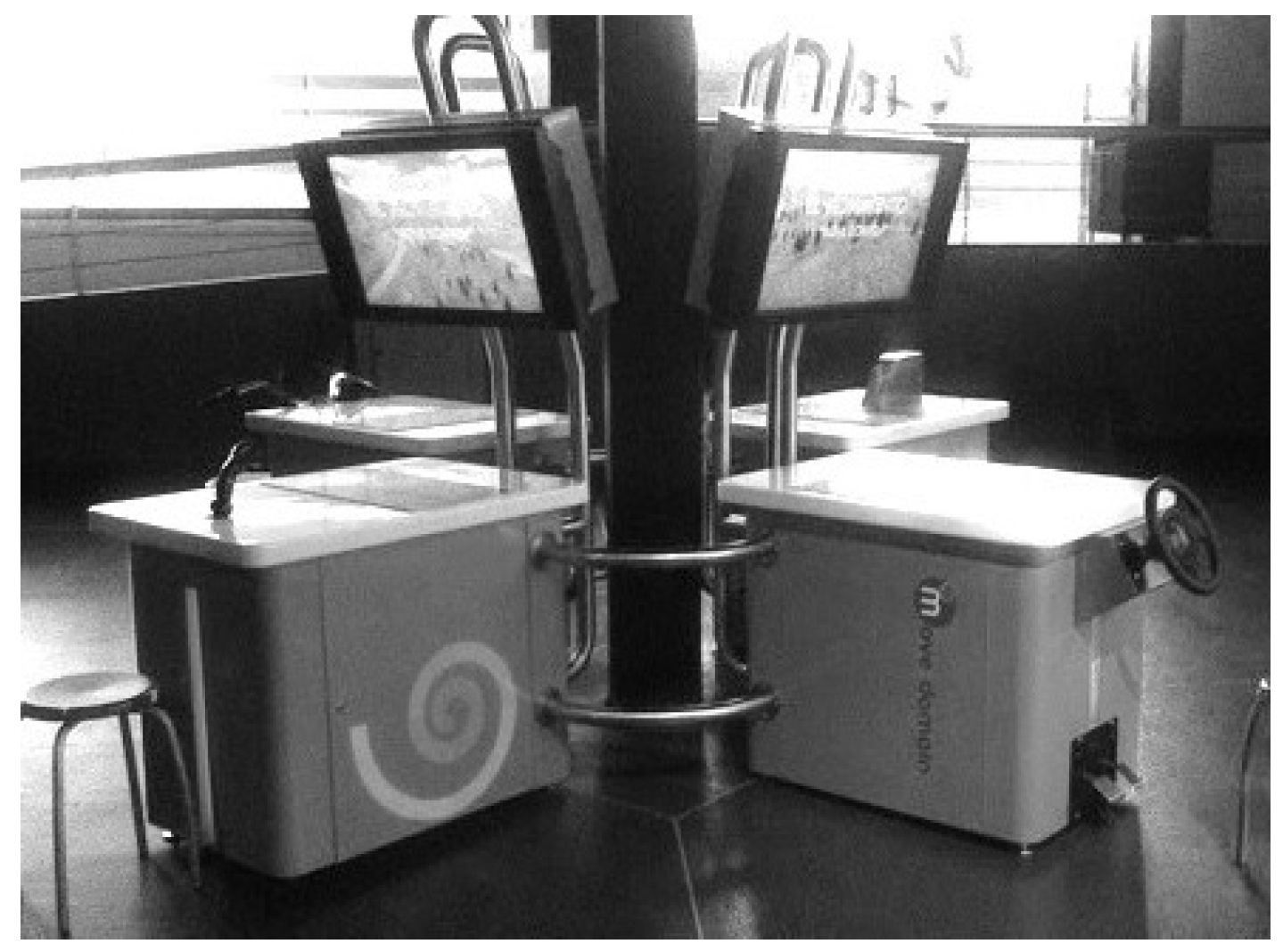
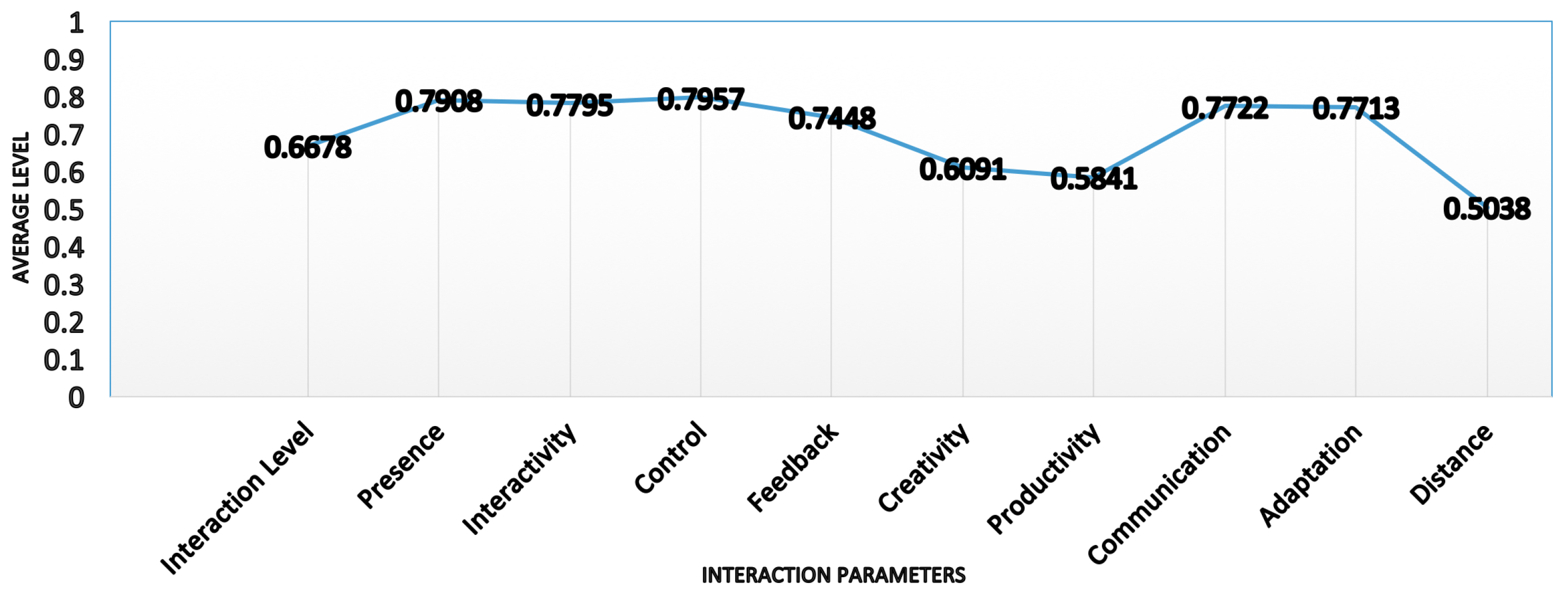
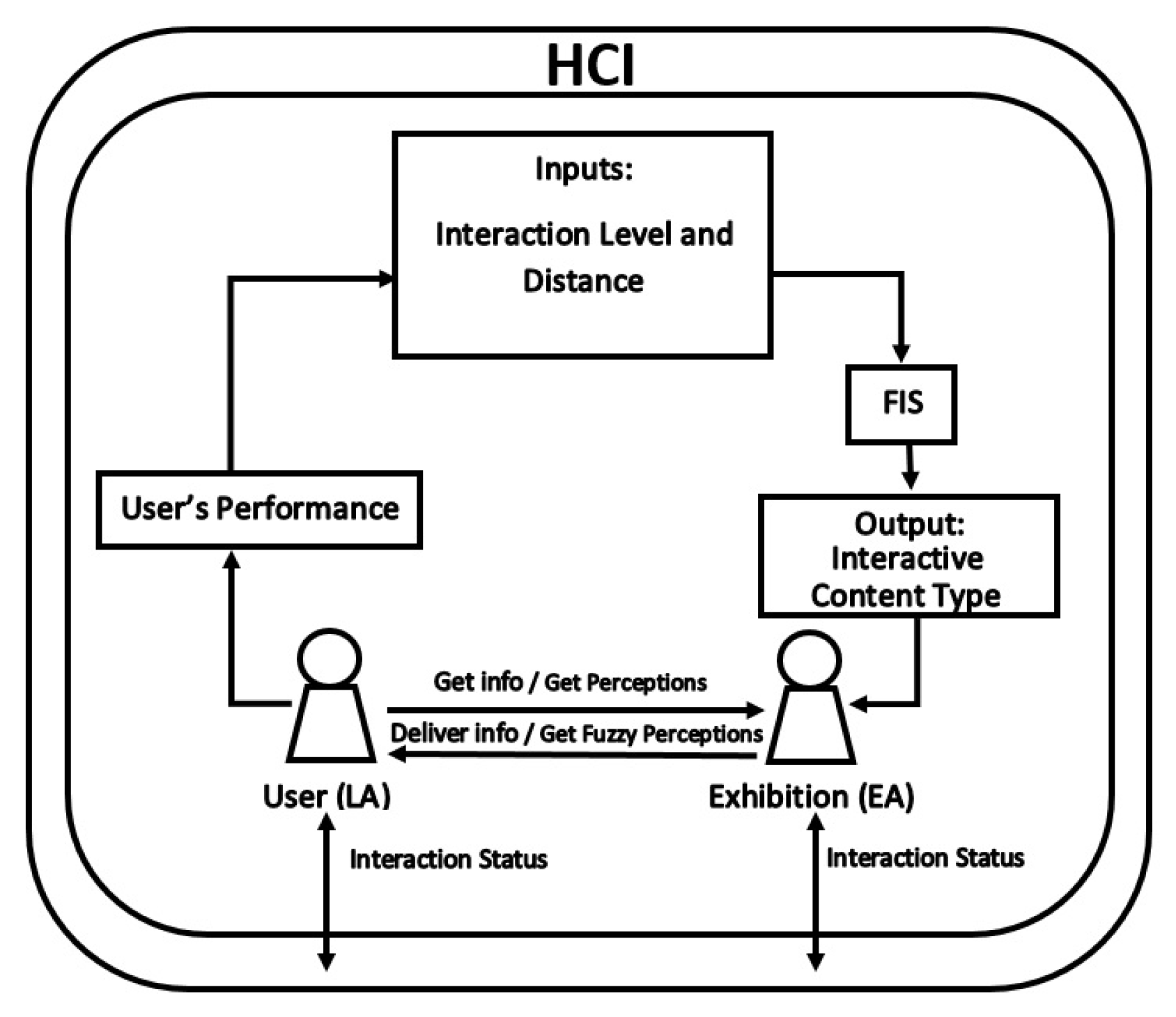
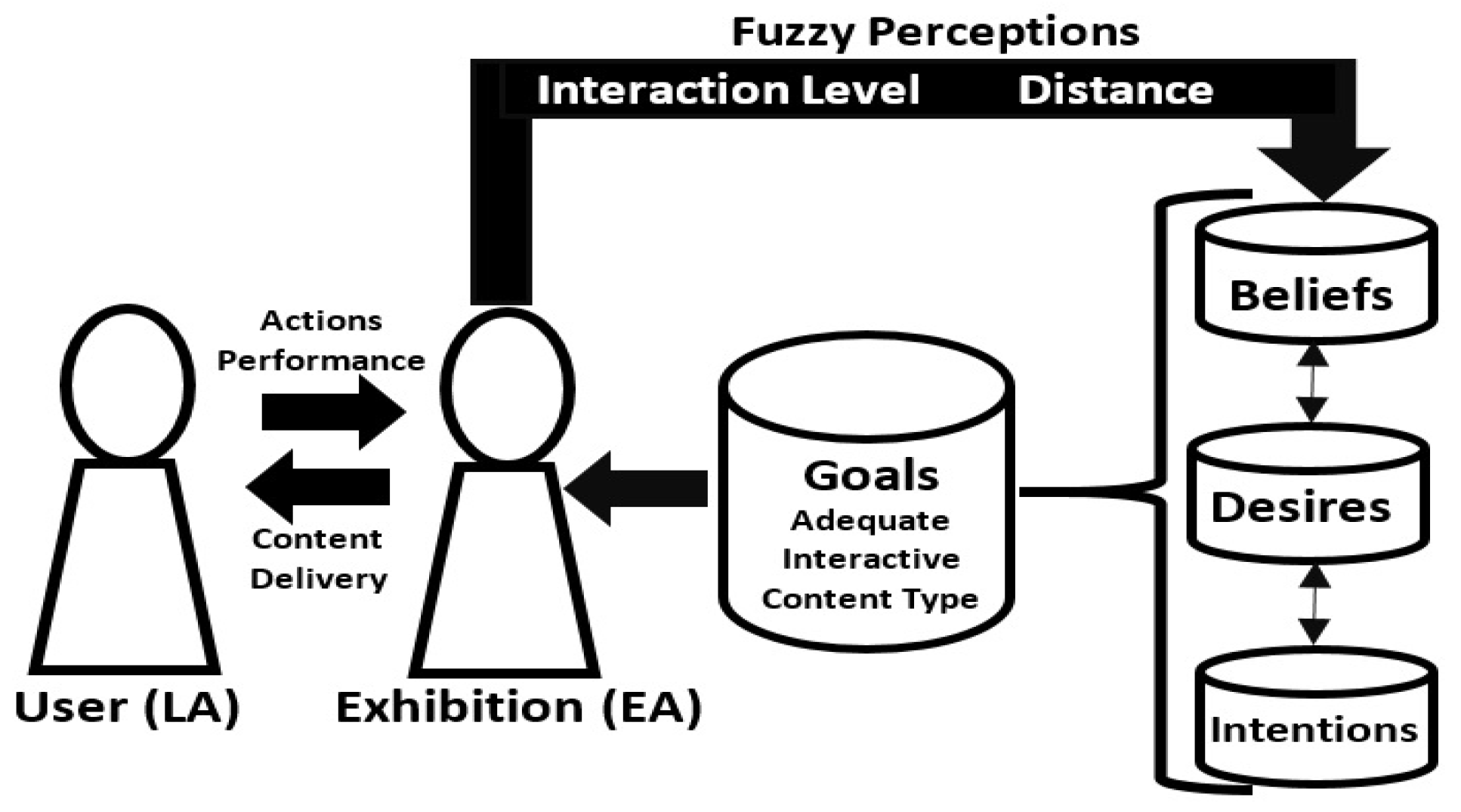
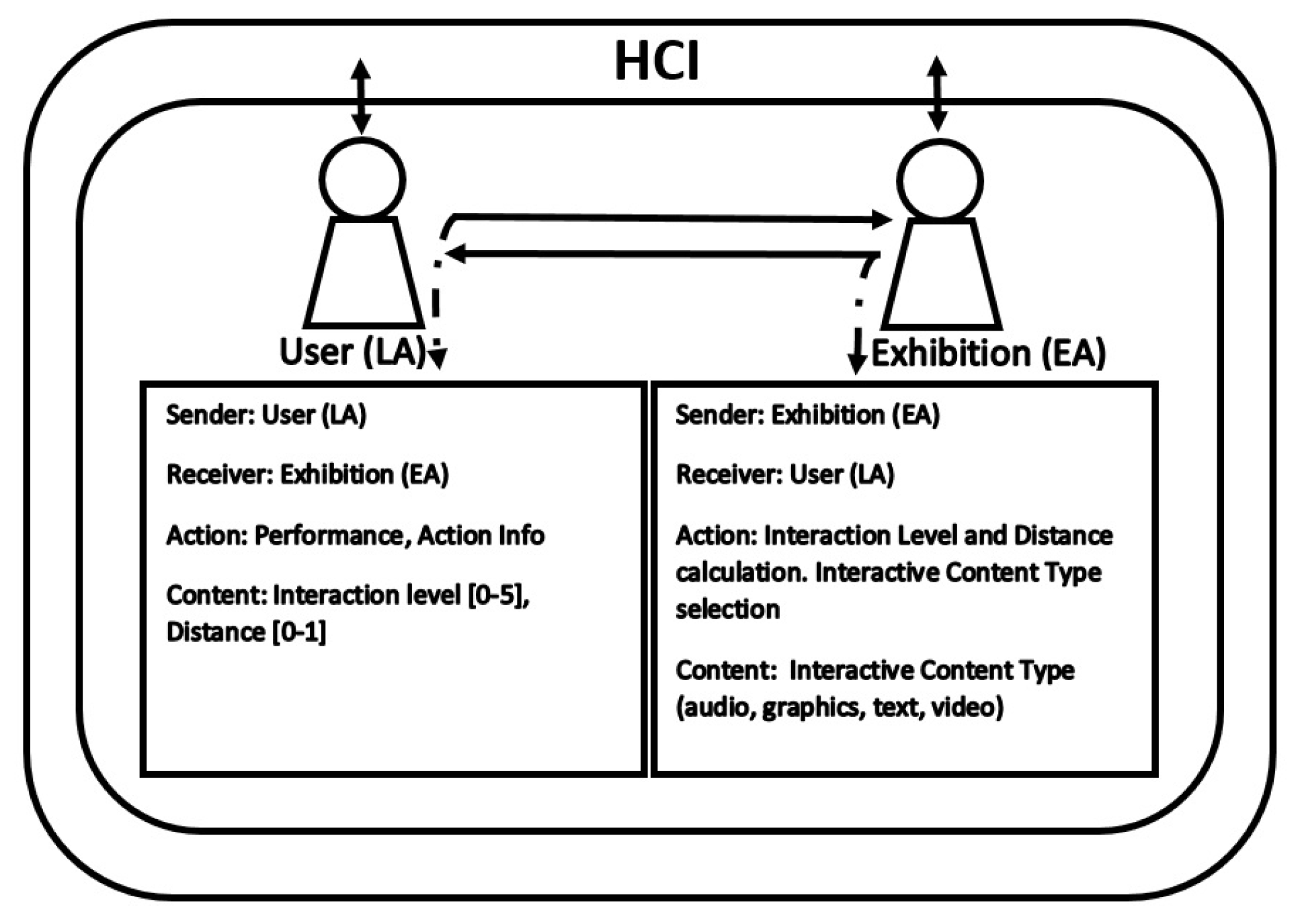

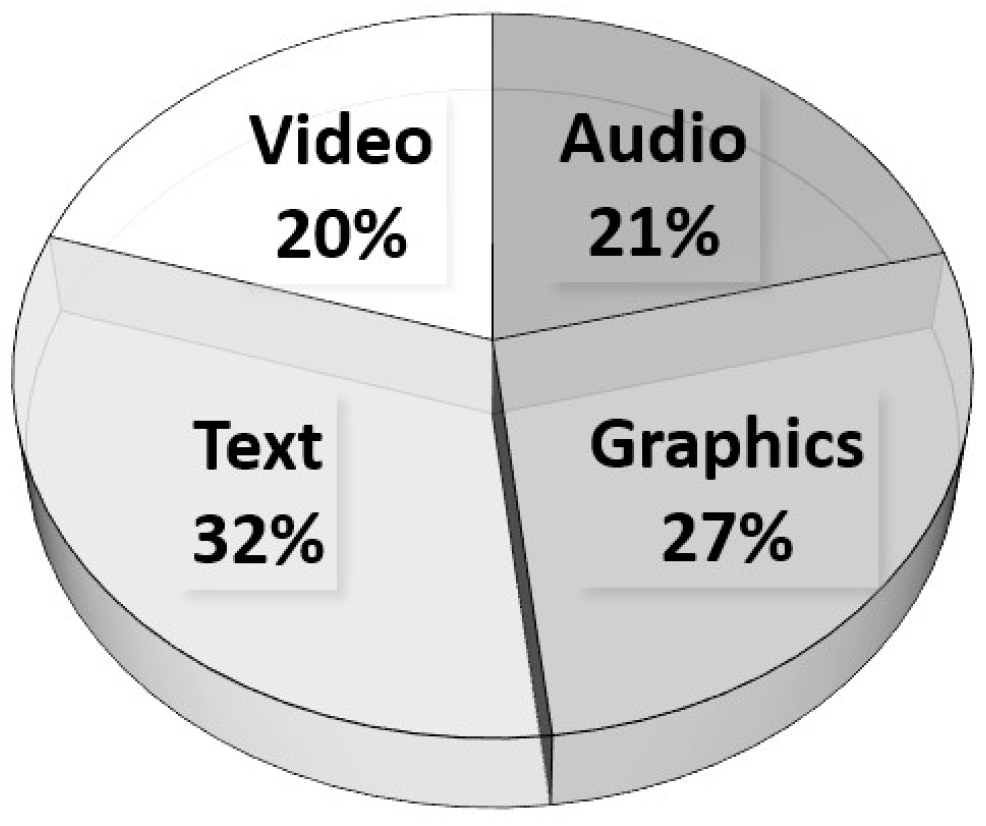
| No | Inference Fuzzy Rules |
|---|---|
| 1 | If (IntL is IntL5) and (Dist is Near) then (IntConType is video) |
| 2 | If (IntL is IntL5) and (Dist is Med) then (IntConType is video) |
| 3 | If (IntL is IntL5) and (Dist is Far) then (IntConType is text) |
| 4 | If (IntL is IntL4) and (Dist is Near) then (IntConType is video) |
| 5 | If (IntL is IntL4) and (Dist is Med) then (IntConType is video) |
| 6 | If (IntL is IntL4) and (Dist is Far) then (IntConType is text) |
| 7 | If (IntL is IntL3) and (Dist is Near) then (IntConType is video) |
| 8 | If (IntL is IntL3) and (Dist is Med) then (IntConType is text) |
| 9 | If (IntL is IntL3) and (Dist is Far) then (IntConType is grfs) |
| 10 | If (IntL is IntL2) and (Dist is Near) then (IntConType is text) |
| 11 | If (IntL is IntL2) and (Dist is Med then (IntConType is text) |
| 12 | If (IntL is IntL2) and (Dist is Far) then (IntConType is audio) |
| 13 | If (IntL is IntL1) and (Dist is Near) then (IntConType is grfs) |
| 14 | If (IntL is IntL1) and (Dist is Med) then (IntConType is grfs) |
| 15 | If (IntL is IntL1) and (Dist is Far) then (IntConType is audio) |
| 16 | If (IntL is IntL0) and (Dist is Near) then (IntConType is grfs) |
| 17 | If (IntL is IntL0) and (Dist is Med) then (IntConType is audio) |
| 18 | If (IntL is IntL0) and (Dist is Far) then (IntConType is audio) |
| Interaction Level | Distance | Element | Description | Source |
|---|---|---|---|---|
| 5 | Near | Belief | video(fuzzy value(.9),(.9)) | percept |
| 2.5 | Medium | Belief | graphics(fuzzy value(.4),(.4)) | percept |
| 0.5 | Far | Belief | audio(fuzzy value(.1),(.1)) | percept |
| 5 | Near | Events | +!select(video) | self |
| 2.5 | Medium | Events | +!select(graphics) | self |
| 0.5 | Far | Events | +!select(audio) | self |
| 5 | Near | Intentions | +!deliver(video) | self |
| 2.5 | Medium | Intentions | +!deliver(graphics) | self |
| 0.5 | Far | Intentions | +!deliver(audio) | self |
| Type | Member Function | Params (Values) |
|---|---|---|
| Input1 (IntLevel) | GaussUncertainty MeanMemberFunction | IntLevel0 = [0.486 1.709 2.196] IntLevel1 = [0.373 2.387 2.761] IntLevel2 = [0.300 3.021 3.321] IntLevel3 = [0.284 3.607 3.891] IntLevel4 = [0.286 3.676 3.963] IntLevel5 = [0.376 4.132 4.508] |
| Input2 (Distance) | GaussUncertainty MeanMemberFunction | Far = [0.196 0.312 0.509] Medium = [0.200 0.372 0.573] Near = [0.217 0.492 0.71] |
| Output (IntConType) | GaussUncertainty MeanMemberFunction | IntCnTypAud = [0.090 0.463 0.554] IntCnTypGph = [0.066 0.597 0.663] IntCnTypTxt = [0.070 0.618 0.689] IntCnTypVid = [0.088 0.792 0.880] |
| Subject | Interaction Level | Distance | Interactive Content Type Using DMT2F |
|---|---|---|---|
| 1 | 1.6738 | 0.4168 | 0.5553 (audio) |
| 2 | 2.0087 | 0.3130 | 0.0.5451 (audio) |
| 3 | 3.0073 | 0.6225 | 0.5921 (graphics) |
| 4 | 4.1161 | 0.8769 | 0.7665 (video) |
| 5 | 4.3935 | 0.3055 | 0.7370 (video) |
| 6 | 3.8101 | 0.3505 | 0.7166 (text) |
| ... | ... | ... | ... |
| 500 | 4.3870 | 0.6969 | 0.7679 (video) |
© 2017 by the authors. Licensee MDPI, Basel, Switzerland. This article is an open access article distributed under the terms and conditions of the Creative Commons Attribution (CC BY) license (http://creativecommons.org/licenses/by/4.0/).
Share and Cite
Rosales, R.; Castañón-Puga, M.; Lara-Rosano, F.; Evans, R.D.; Osuna-Millan, N.; Flores-Ortiz, M.V. Modelling the Interruption on HCI Using BDI Agents with the Fuzzy Perceptions Approach: An Interactive Museum Case Study in Mexico. Appl. Sci. 2017, 7, 832. https://doi.org/10.3390/app7080832
Rosales R, Castañón-Puga M, Lara-Rosano F, Evans RD, Osuna-Millan N, Flores-Ortiz MV. Modelling the Interruption on HCI Using BDI Agents with the Fuzzy Perceptions Approach: An Interactive Museum Case Study in Mexico. Applied Sciences. 2017; 7(8):832. https://doi.org/10.3390/app7080832
Chicago/Turabian StyleRosales, Ricardo, Manuel Castañón-Puga, Felipe Lara-Rosano, Richard David Evans, Nora Osuna-Millan, and Maria Virginia Flores-Ortiz. 2017. "Modelling the Interruption on HCI Using BDI Agents with the Fuzzy Perceptions Approach: An Interactive Museum Case Study in Mexico" Applied Sciences 7, no. 8: 832. https://doi.org/10.3390/app7080832
APA StyleRosales, R., Castañón-Puga, M., Lara-Rosano, F., Evans, R. D., Osuna-Millan, N., & Flores-Ortiz, M. V. (2017). Modelling the Interruption on HCI Using BDI Agents with the Fuzzy Perceptions Approach: An Interactive Museum Case Study in Mexico. Applied Sciences, 7(8), 832. https://doi.org/10.3390/app7080832






